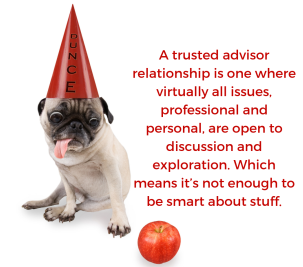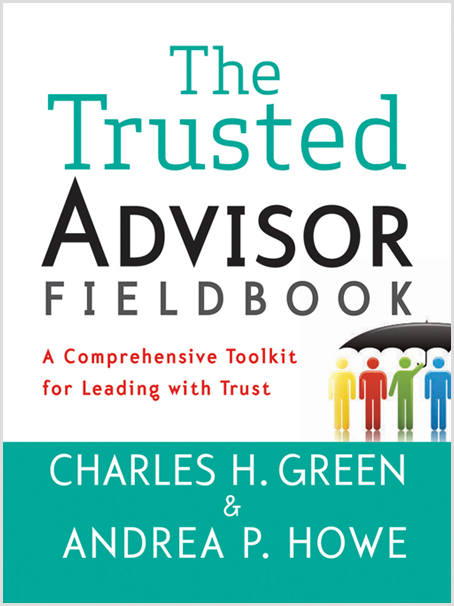This post is part of our Weekly Tips series.

If we had a do-over for The Trusted Advisor Fieldbook, there’d be a whole chapter on how you see your value, and how your own mentality is a key driver of your clients’ proclivity to see you more consistently as a trusted advisor. For now, a weekly tip will have to suffice.
Most services professionals tie their value to their expertise. That makes sense, since most clients pay money for the expertise they need to advance a business issue.
The thing is, a trusted advisor is much more than a trusted problem-solver.
Think of a stair-step with four levels, each of which provides a different kind of value, and a different kind of listening:
- Level 1: Information-giver. Someone with valuable expertise to offer. Your interactions tend to be more transactional, though highly valuable in terms of content. When you primarily see your value in this way, you’ll listen for opportunities to share what you know.
- Level 2: Problem-solver. Someone with the ability to apply knowledge in a collaborative way to resolves issues. Your focus tends to be on a particular solution set, consistent with the problem at hand and/or your body of knowledge. You routinely listen for familiar issues with known solutions.
- Level 3: Idea-generator. Someone who brings a bigger picture perspective to a particular business challenge. Your focus is more holistic and includes a range of solution sets. You’ll tend to listen for context, business drivers, and systemic implications.
- Level 4: Trusted advisor. A safe haven for tough issues. A trusted advisor relationship is one where virtually all issues, professional and personal, are open to discussion and exploration. It’s marked by both a broad range of business topics and a deep personal relationship. (Note that you’re a safe haven for tough issues, period, not a safe haven for tough issues for which you have a product or service.) You’ll listen for emotions as well as facts, and personal drivers, not just business ones.
It’s not wrong to operate at the so-called lower levels—in fact, most of our daily professional lives are spent there. Plus, sometimes the best way to provide value is to operate at all the levels—even in a single conversation.
The keys, though, are (1) to see your value broadly so that you don’t miss opportunities and (2) to cultivate your ability to step up or down, comfortably and like that (insert finger snap here), when it’s called for.
Make It Real
This week, examine three key client relationships. At which level are you spending most of your time with each? How might you see your value differently in order to provide greater value?
Learn More

Read about the problems with the “brain surgeon” model for consulting, from our friends at Trusted Advisor Associates, or brush up on key partnering traits in Chapter 7 of The Trusted Advisor Fieldbook.
Andrea Howe
Latest posts by Andrea Howe (see all)
- Why choosing silence in the face of awkwardness can be a trust tragedy - March 21, 2024
- What NOT to do when you think you’re being ghosted - February 21, 2024
- Reprise: If you’ve resolved to have better client relationships this year, great, now ditch your resolution - January 2, 2024
